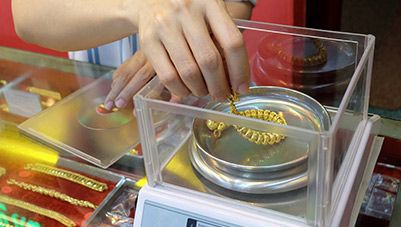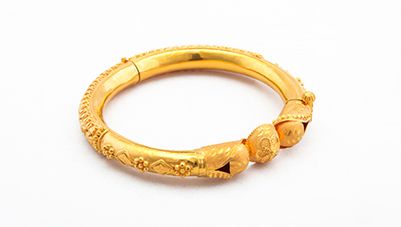Rs. 5,000 - Rs. 2 crore
To find the nearest gold loan branch,
Enter phone and OTP | Check amount you can get | Apply for quick funds
Understanding gold karats and their role in valuation
Gold is more than just a precious metal in India—it’s both a cultural symbol and a smart financial asset. Its purity is measured in karats, with 24K being pure gold. Many people use gold as collateral for gold loans, making it easy to get quick funds without lengthy paperwork or credit checks. Banks and financial institutions accept gold ornaments or coins and offer loans based on a percentage of the gold’s value at competitive interest rates. These loans are especially handy for short-term needs and in areas with limited banking access. So, gold isn’t just for tradition—it’s a practical way to secure fast financial support when you need it.
What are the different types of gold?
Gold, a precious metal, is available in various types, each with unique characteristics. Here are some of them:
- 24 karat gold: The purest form of gold, it is 99.9% pure. It’s the most expensive and has a bright yellow colour.
- 18 karat gold: Comprising 75% gold and 25% other metals, it’s stronger and more durable than 24K gold.
- 14 karat gold: Popular in the US, it contains 58.3% gold and 41.7% other metals.
- 10 karat gold: The lowest gold alloy, it’s strong but contains only 41.7% gold.
- Gold alloys: These include Yellow, White, Rose, Green, Purple, Blue, and Black Gold. They are created by mixing gold with other metals, giving them unique colours.
- Gold plating, vermeil, rolled, and filled gold: These types involve coating a base metal with a layer of gold.
Each type of gold has its own value, strength, and colour, making it suitable for different uses. The type of gold used in jewellery significantly impacts its value and durability.
Different colours of gold
Gold, a precious metal, can be alloyed with other metals to create a variety of colours. Here are some of the most common ones:
- Yellow gold: The yellow gold is the purest colour of gold. It’s made by mixing gold with silver, copper, and zinc. It’s the most hypoallergenic and requires the least maintenance.
- White gold: A modern and sleek option, the white gold is made of gold and platinum or palladium. It’s more durable and scratch-resistant than yellow gold.
- Rose gold: A romantic and warm colour, it’s alloyed with gold, copper, and silver. Due to its copper content, rose gold is more durable than yellow or white gold.
- Green gold: A soft and natural colour, it’s mixed with gold, silver, and sometimes copper. Silver gives the gold alloy the green nuance.
- Grey gold: A neutral and subtle colour, it’s a unique blend of gold and other metals.
- Purple gold: A brittle and exotic colour, it’s a rare type of gold.
- Blue gold: A cool and dark colour, it’s another unique type of gold.
- Black gold: A bold and mysterious colour, it’s created through various methods, including alloying and surface treatments.
The colour of gold is not just limited to the traditional yellow. By alloying gold with various metals, we can achieve a spectrum of colours like white, rose, green, grey, purple, blue, and even black. Each colour has its unique composition and characteristics, offering a wide range of options for jewellery and other decorative items. This diversity in gold colours allows for personalisation and expression through this precious metal.
Wondering how much you can borrow on your gold? Just check your gold loan eligibility—it takes seconds and minimal paperwork!
Different types of gold coatings
Gold coatings, or plating, involve applying a thin layer of gold onto a base metal. Here are some types:
- Gold plated: This involves electroplating a very light layer of gold (0.05% of actual gold or less) on top of a base metal like copper, brass, nickel, or aluminium.
- Gold vermeil: This is heavy gold plating over sterling silver. The layer needs to be at least 2.5 microns thick, and the minimum gold purity used should be 10 karats.
- Hard gold plated: This is a variant where a substantial layer of gold is deposited onto a substrate.
- Soft gold plate, duplex gold plated, vacuum gold plated, chemical plated, and immersion gold plated: These are other types of gold plating with varying characteristics and uses.
Types of jewellery filling
Here are the common types of gold filling:
Gold-filled/rolled gold
Gold-filled, often referred to as rolled gold, is a material made by heat and pressure-bonding a thin layer of gold to a brass core. The exterior gold layer must account for at least 5% of the item’s total weight. Gold-filled items are highly resistant to tarnish and the gold layer can last for many years, even with daily wear. It’s an affordable alternative to solid gold, offering the same luxurious look and feel. Gold-filled jewellery is a popular choice for its durability, affordability, and resemblance to pure gold. It’s a great option for those with metal sensitivities.
2. Vermeil
Vermeil is gold-plated sterling silver, with a gold layer of at least 10K and 2.5 microns thick. It is more durable than standard gold plating, giving a luxurious look without high costs. Over time, silver may show through, but it remains a stylish, budget-friendly option.
3. Gold plated
Gold-plated jewellery has a very thin gold layer applied to base metals like brass, copper, or silver. It gives the appearance of gold at a low cost but can wear off with frequent use or exposure to chemicals, requiring occasional replating.
Conclusion
Gold loans generally have lower interest rates than other types of loans since gold serves as collateral. However, the interest rate may vary depending on the gold rate. When the gold rate is high, the interest rates are lower as the higher value of the collateral diminishes the risk. Understanding the types of gold and their impact on gold loans can help borrowers make informed decisions and choose the loan that best fits their unique situation and requirements.
The gold loan interest rates typically have lower interest rates compared to other types of loans, ranging between 9.50% to 24% p.a. The exact rate depends on various factors, including the lender’s policies and the prevailing market conditions.
Know how much you can borrow on your gold jewellery—check your gold loan eligibility instantly for a smooth and transparent process.
Types of gold and their impact on gold loans
Gold loans are a popular form of secured loan in India, where gold jewellery, ornaments, or coins are used as collateral. The type of gold and its purity can significantly impact the terms of a gold loan. There are several types of gold that can be used for these loans. Gold jewellery is the most common form used as collateral.
The loan amount depends on the purity and current market value of the gold. Gold for farmers is a specialised type of gold loan catering to the financial needs of farmers. These loans often feature lower interest rates and repayment schedules aligned with crop cycles. A gold overdraft facility provides ongoing access to funds using gold as collateral.
Factors affecting gold loan amount based on gold type
- The amount of a gold loan is influenced by several factors, primarily the type and quality of gold. The purity of gold, measured in karats, is a significant determinant. Gold items of 22 karats or higher are usually valued higher, leading to a larger loan amount.
- The weight of the gold also plays a crucial role. Lenders typically offer loans up to a certain percentage of the gold’s value, as per Reserve Bank of India guidelines.
- The current market price of gold is another critical factor. As gold prices rise, the loan amount you can secure against your gold also increases.
- The Loan-to-Value (LTV) ratio, which is the percentage of the gold’s value that lenders are willing to lend as a loan, also affects the loan amount.
- The presence of decorative items, diamonds, or precious stones in your gold jewellery can affect the overall value, as these are generally not considered in the rate per gram.
Related Articles
Disclaimer
Bajaj Finance Limited has the sole and absolute discretion, without assigning any reason to accept or reject any application. Terms and conditions apply*.
For customer support, call Personal Loan IVR: 7757 000 000









 Personal Loan
Personal Loan Check Eligibility
Check Eligibility Salaried Personal Loan
Salaried Personal Loan EMI Calculator
EMI Calculator Account Aggregator
Account Aggregator Credit Pulse Report
Credit Pulse Report
 Deals starting @99
Deals starting @99 Min. 50% off
Min. 50% off
 Bajaj Pay
Bajaj Pay Wallet to Bank
Wallet to Bank
 Easy EMI Loan
Easy EMI Loan Savings Offer
Savings Offer Smartphones
Smartphones Led TVs
Led TVs Washing Machines
Washing Machines Laptops
Laptops Refrigerators
Refrigerators Air Conditioner
Air Conditioner Air Coolers
Air Coolers
 Loan Against Shares
Loan Against Shares Loan Against Mutual Funds
Loan Against Mutual Funds Loan Against Insurance Policy
Loan Against Insurance Policy ESOP Financing
ESOP Financing Easy EMI Loan
Easy EMI Loan Two-wheeler Loan
Two-wheeler Loan Loan for Lawyer
Loan for Lawyer Industrial Equipment Finance
Industrial Equipment Finance Industrial Equipment Balance Transfer
Industrial Equipment Balance Transfer Industrial Equipment Refinance
Industrial Equipment Refinance Personal Loan Branch Locator
Personal Loan Branch Locator Used Tractor Loan
Used Tractor Loan Loan Against Tractor
Loan Against Tractor Tractor Loan Balance Transfer
Tractor Loan Balance Transfer Flexi
Flexi View All
View All
 Two-wheeler Loan
Two-wheeler Loan Bike
Bike Scooter
Scooter Electric Vehicle
Electric Vehicle Best Sellers
Best Sellers Popular Brands
Popular Brands

 Trading Account
Trading Account Open Demat Account
Open Demat Account Margin Trading Financing
Margin Trading Financing Share Market
Share Market Invest in IPO
Invest in IPO All stocks
All stocks Top gainers
Top gainers Top losers
Top losers 52 week high
52 week high 52 week low
52 week low Loan against shares
Loan against shares
 Home Loan
Home Loan Transfer your existing Home loan
Transfer your existing Home loan Loan against Property
Loan against Property Home Loan for Salaried
Home Loan for Salaried Home loan for self employed
Home loan for self employed Loan Against Property Balance Transfer
Loan Against Property Balance Transfer Home Loan EMI Calculator
Home Loan EMI Calculator Home Loan eligibility calculator
Home Loan eligibility calculator Home Loan balance transfer
Home Loan balance transfer View All
View All
 Term Life Insurance
Term Life Insurance ULIP Plan
ULIP Plan Savings Plan
Savings Plan Family Insurance
Family Insurance Senior Citizen Health Insurance
Senior Citizen Health Insurance Critical Illness Insurance
Critical Illness Insurance Child Health Insurance
Child Health Insurance Pregnancy and Maternity Health Insurance
Pregnancy and Maternity Health Insurance Individual Health Insurance
Individual Health Insurance Low Income Health Insurance
Low Income Health Insurance Student Health Insurance
Student Health Insurance Group Health Insurance
Group Health Insurance Retirement Plans
Retirement Plans Child Plans
Child Plans Investment Plans
Investment Plans
 Business Loan
Business Loan Secured Business Loan
Secured Business Loan Loan against property
Loan against property Loans against property balance transfer
Loans against property balance transfer Loan against shares
Loan against shares Home Loan
Home Loan Loans against mutual funds
Loans against mutual funds Loan against bonds
Loan against bonds Loan against insurance policy
Loan against insurance policy
 Apply for Gold Loan
Apply for Gold Loan Transfer your Gold Loan with Us
Transfer your Gold Loan with Us Gold Loan Branch Locator
Gold Loan Branch Locator
 ULIP Plan
ULIP Plan Savings Plan
Savings Plan Retirement Plans
Retirement Plans Child Plans
Child Plans Free Demat Account
Free Demat Account Invest in Stocks
Invest in Stocks Invest in IPO
Invest in IPO Margin Trading Facility
Margin Trading Facility Fixed Deposit Branch Locator
Fixed Deposit Branch Locator
 Check your Credit Score
Check your Credit Score
 New Car Loan
New Car Loan Used Car Loan
Used Car Loan Loan Against Car
Loan Against Car Car Loan Balance Transfer and Top-up
Car Loan Balance Transfer and Top-up
 Get Bajaj Prime
Get Bajaj Prime
 Mobiles on EMI
Mobiles on EMI Electronics on EMI Offer
Electronics on EMI Offer  Iphone on EMI
Iphone on EMI LED TV on EMI
LED TV on EMI Refrigerator on EMI
Refrigerator on EMI Laptop on EMI
Laptop on EMI Kitchen appliances on EMI
Kitchen appliances on EMI Washing machines
Washing machines
 Personal Loan EMI Calculator
Personal Loan EMI Calculator Personal Loan Eligibility Calculator
Personal Loan Eligibility Calculator Home Loan EMI Calculator
Home Loan EMI Calculator Home Loan Eligibility Calculator
Home Loan Eligibility Calculator Good & Service Tax (GST) Calculator
Good & Service Tax (GST) Calculator Flexi Day Wise Interest Calculator
Flexi Day Wise Interest Calculator Flexi Transaction Calculator
Flexi Transaction Calculator Secured Business Loan Eligibility Calculator
Secured Business Loan Eligibility Calculator Fixed Deposits Interest Calculator
Fixed Deposits Interest Calculator Two wheeler Loan EMI Calculator
Two wheeler Loan EMI Calculator New Car Loan EMI Calculator
New Car Loan EMI Calculator Used Car Loan EMI Calculator
Used Car Loan EMI Calculator All Calculator
All Calculator Used Tractor Loan EMI Calculator
Used Tractor Loan EMI Calculator
 Hot Deals
Hot Deals Clearance Sale
Clearance Sale Kitchen Appliances
Kitchen Appliances Tyres
Tyres Camera & Accessories
Camera & Accessories Mattresses
Mattresses Furniture
Furniture Watches
Watches Music & Audio
Music & Audio Cycles
Cycles Mixer & Grinder
Mixer & Grinder Luggage & Travel
Luggage & Travel Fitness Equipment
Fitness Equipment Fans
Fans
 Personal Loan for Doctors
Personal Loan for Doctors Business loan for Doctors
Business loan for Doctors Home Loan
Home Loan Secured Business Loan
Secured Business Loan Loan against property
Loan against property Secured Business Loan Balance Transfer
Secured Business Loan Balance Transfer Loan against share
Loan against share Gold Loan
Gold Loan Medical Equipment Finance
Medical Equipment Finance
 Engagement Zone
Engagement Zone Game Zone
Game Zone
 Savings Offer
Savings Offer Easy EMI
Easy EMI Offer World
Offer World 1 EMI OFF
1 EMI OFF New Launches
New Launches Zero Down Payment
Zero Down Payment Clearance Sale
Clearance Sale Bajaj Mall Sale
Bajaj Mall Sale
 Mobiles under ₹20,000
Mobiles under ₹20,000 Mobiles under ₹25,000
Mobiles under ₹25,000 Mobiles under ₹30,000
Mobiles under ₹30,000 Mobiles under ₹35,000
Mobiles under ₹35,000 Mobiles under ₹40,000
Mobiles under ₹40,000 Mobiles under ₹50,000
Mobiles under ₹50,000
 Articles
Articles
 Overdue Payments
Overdue Payments Other Payments
Other Payments
 Document Center
Document Center Bank details & Documents
Bank details & Documents Tax Invoice Certificate
Tax Invoice Certificate
 Do Not Call Service
Do Not Call Service
 Hamara Mall Orders
Hamara Mall Orders

 Fixed Deposit (IFA) Partner
Fixed Deposit (IFA) Partner Loan (DSA) Partner
Loan (DSA) Partner Debt Management Partner
Debt Management Partner EMI Network Partner
EMI Network Partner Became a Merchant
Became a Merchant Partner Sign-in
Partner Sign-in
 Mobiles on EMI
Mobiles on EMI Trade directly with your Demat A/c
Trade directly with your Demat A/c ITR
ITR My Garage
My Garage
 Live Videos - Beta
Live Videos - Beta
 Savings Offer
Savings Offer Smartphones
Smartphones LED TVs
LED TVs Washing Machines
Washing Machines Laptops
Laptops Refrigerators
Refrigerators Air Conditioners
Air Conditioners Air Coolers
Air Coolers Water Purifiers
Water Purifiers Tablets
Tablets Kitchen Appliances
Kitchen Appliances Mattresses
Mattresses Furniture
Furniture Music and Audio
Music and Audio Cameras & Accessories
Cameras & Accessories Cycle
Cycle Watches
Watches Tyres
Tyres Luggage & Travel
Luggage & Travel Fitness Equipment
Fitness Equipment Tractor
Tractor Easy EMI Loan
Easy EMI Loan
 vivo Mobiles
vivo Mobiles OPPO Mobiles
OPPO Mobiles Xiaomi Mobiles
Xiaomi Mobiles Sony LED TVs
Sony LED TVs Samsung LED TVs
Samsung LED TVs LG LED TVs
LG LED TVs Haier LED TVs
Haier LED TVs Godrej Refrigerators
Godrej Refrigerators Voltas Washing Machines
Voltas Washing Machines
 New Tractor Loan
New Tractor Loan Used Tractor Loan
Used Tractor Loan Loan Against Tractor
Loan Against Tractor Tractor Loan Balance Transfer
Tractor Loan Balance Transfer









